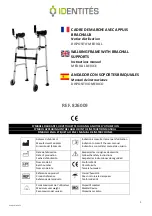
Final
Report № AIFN/0010/2018, issued on 10 January 2022
1
1.
Factual Information
1.1
History of the Flight
On 18 September 2018, Air Arabia Airbus A320 Aircraft, registration A6-ANV, was
scheduled to operate commercial flight ABY111 from Sharjah International Airport (OMSJ), the
United Arab Emirates, to Salalah International Airport (OOSA), Sultanate of Oman. The flight
occupants were the Commander, who was a training captain, the Copilot, whose designation was
a second officer under training, 4 cabin crewmembers, and 42 passengers.
The flight crew were off duty for 33 hours before the flight. They arrived
at the Operator’s
dispatch at approximately 1120 UTC.
The flight preparation went normally, and there was no evidence of rushing the
before
start
checklist. The take-off mass was well below the maximum.
The flight documents, including the weather report, operational flight plan (OFP), and
departure procedures, were checked and discussed between both flight crewmembers before the
flight.
The Copilot was the pilot flying (PF), and it was her first flight to OOSA. The Commander
stated that he briefed the Copilot that the taxi would be on a single engine with the second engine
start during the taxi. The Commander briefed the Copilot for intersection and rolling takeoff as part
of her training subjects. The responsibility for engine start and air traffic communications was the
Commander’s, whereas the Copilot was responsible for taxiing the Aircraft.
The Aircraft take-off mass was 56.7 tons, center of gravity 27.36%, and the fuel on-board
10,100 kg. The Aircraft configuration for takeoff was flap setting of 1+F using engine thrust setting
at FLX/MCT (Flex temperature of 67 degrees Celsius). The OFP
‘take-off data’ speeds were: 122
knots V
1
; 127 knots V
R
; and 129 knots V
2
. The flight crew entered all relevant flight performance
data
, including the runway in use ‘runway 30’, in the Aircraft flight management system (FMS)
through the multipurpose control and display unit (MCDU).
According to the Operator
’s procedure, the flight crew were provided with OFP that
included the calculated speeds, but it did not include the accelerate-stop distance required to safely
stop the Aircraft in case of rejected takeoff. The OFP stated in the matrix of data that for a takeoff
on runway 30 at Bravo 14 intersection, the take-off distance available would be 3,050 meters, which
was about 1,000 meters shorter that the runway length.
The pushback clearance was given to face east for runway 30. During the pushback from
the parking stand, the left engine (No. 1) was started by the Commander. At 1220:22, the ground
air traffic control (ATC) granted taxi clearance
which stated: “taxi runway three-zero, Bravo one-
four, taxi Alpha and Alpha 14 at the holding point contact Tower.
”
At 1220:55, the taxi commenced. At 1221:43, during the taxi, the right engine (No. 2) start
was completed by the Commander and the Aircraft reached Bravo 14 runway 12/30 holding point
at 1223.52. The parking brake was set, and the flight crew completed the
before takeoff checklist
‘down to the line’
.
At 1224:21, the Commander communicated with the Tower stating:
“Good afternoon,
Arabia triple-one Bravo fourteen ready for departure.
” The Commander read back the Tower
clearance stating:
“Clear for takeoff, Bravo fourteen, Runway three zero Arabia triple one. Thank
you.
”
The crew did not inform the Tower about the planned rolling takeoff.
The Copilot then asked
the Commander for completion of the
before takeoff checklist
‘below the line’ check items.












































